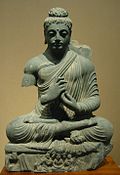| Part of a series on |
| Buddhist philosophy |
|---|
 |
|
|
Buddhist logico-epistemology is a term used in Western scholarship to describe Buddhist systems of pramāṇa (epistemic tool, valid cognition) and hetu-vidya (reasoning, logic).[1][2]: 12 While the term may refer to various Buddhist systems and views on reasoning and epistemology, it is most often used to refer to the work of the "Epistemological school" (Sanskrit: Pramāṇa-vāda), i.e. the school of Dignaga and Dharmakirti which developed from the 5th through 7th centuries and remained the main system of Buddhist reasoning until the decline of Buddhism in India.[3][4]
The early Buddhist texts show that the historical Buddha was familiar with certain rules of reasoning used for debating purposes and made use of these against his opponents. He also seems to have held certain ideas about epistemology and reasoning, though he did not put forth a logico-epistemological system.
The Theravada Kathāvatthu contains some rules on debate and reasoning. The first Buddhist thinker to discuss logical and epistemic issues systematically was Vasubandhu in his Vāda-vidhi (A Method for Argumentation).[5] A mature system of Buddhist logic and epistemology was founded by the Buddhist scholar Dignāga (c. 480–540 CE) in his magnum opus, the Pramāṇa-samuccaya.[6][7] Dharmakirti further developed this system with several innovations in his Pramanavarttika ("Commentary on Valid Cognition"). His work was influential on all later Buddhist philosophical systems as well as on numerous Hindu thinkers. It also became the main source of epistemology and reasoning in Tibetan Buddhism.[8]
- ^ Cite error: The named reference
:0was invoked but never defined (see the help page). - ^ Cite error: The named reference
Dreyfus1997was invoked but never defined (see the help page). - ^ for examples of this usage of "epistemological school", see: Ratié, I. Otherness in the Pratyabhijñā philosophy. J Indian Philos 35, 313–370 (2007). https://doi.org/10.1007/s10781-007-9017-5; and: Muroya, Y. The Nyāyamukha and udghaṭitajña . J Indian Philos 45, 281–311 (2017). https://doi.org/10.1007/s10781-016-9309-8
- ^ In German, it is also known as "Erkenntnistheoretischen Schule", see: Steinkellner, Ernst, and Michael Torsten Much. 1995. Texte der erkenntnistheoretischen Schule des Buddhismus: systematische Übersicht über die buddhistische Sanskrit-Literatur II. Abhandlungen der Akademie der Wissenschaften in Göttingen: Philologisch-Historische Klasse. Göttingen: Vandenhoeck & Ruprecht.
- ^ Anacker, Stefan (2005) [1984]. Seven Works of Vasubandhu: The Buddhist Psychological Doctor. Delhi, India: Motilal Banarsidass. p. 31.
- ^ Tucci, Giuseppe (1929). "Buddhist Logic before Dinnaga (Asanga, Vasubandhu, Tarka-sastras)". Journal of the Royal Asiatic Society of Great Britain and Ireland. 61 (3): 451–488. doi:10.1017/S0035869X00151524. S2CID 162557402.
- ^ Sadhukhan, Sanjit Kumar (1994). Tobden, Tashi (ed.). "A Short History of Buddhist Logic in Tibet" (PDF). Bulletin of Tibetology. New Series. 30 (3). Gangtok, Sikkim: Sikkim Research Institute of Tibetology: 7–8. Archived (PDF) from the original on 2018-06-27. Retrieved 2009-03-14. Alt URL
- ^ Hugon, Pascale, "Tibetan Epistemology and Philosophy of Language", The Stanford Encyclopedia of Philosophy (Spring 2015 Edition), Edward N. Zalta (ed.)